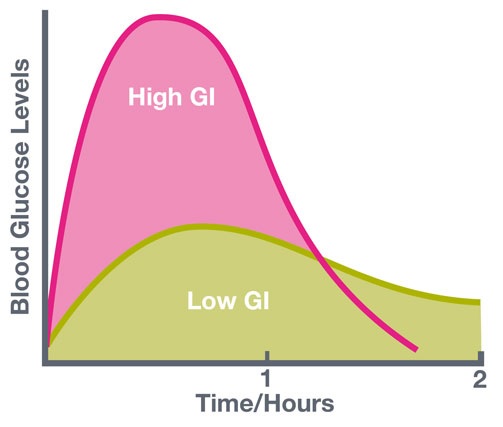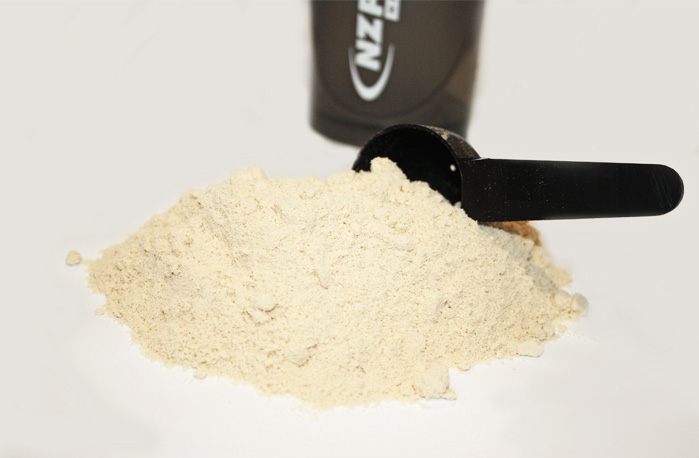
You may have heard of the terms Glycaemic Index and/or Load before and wondered about their meaning and use. These technical terms actually refer to a simple concept - how much and how fast sugar is released in the blood after consuming food containing carbohydrates.
Glycaemic Index vs Glycaemic Load
What is the difference between Glycaemic Index (GI) and Glycaemic Load (GL)?
When it comes to glycaemic index foods are ranked on a scale from 0 to 100. The higher the number, the higher the impact on your blood sugar levels.
Generally, dieticians consider that anything with a GI of less than 55 has a low impact on blood sugar levels. Anything above 70 is considered high impact. Anything between these two figures has a moderate impact.
Foods with a high GI get digested quickly and their glucose content rapidly shows in the blood.
The glycaemic load paints a broader picture.
It not only tells you the impact of the food on your blood sugar levels, but it also tells you how much glucose the food contains and can actually be released in your blood. This takes into account the actual glucose content of a food, or, you could say - the serving size of a food.
Glycaemic load is divided between low (0 to 10), medium (11 to 19) and high load (above 20).
For example, a large piece of a high GI fruit is not the same as an equally large piece of cake. Watermelon is often taken to illustrate the difference between the two terms: while its GI is 80, its load is merely 5. You would need to eat a LOT of watermelon to actually get a nefarious blood glucose level.
Why do these figures matter? The body does not like having high sugar levels circulating in the blood. It is highly inflammatory and over time it can damage your blood vessels and, subsequently, various organs in your body.
A food with a low GI will be absorbed and digested more slowly than one with a high GI. Your blood glucose levels will not go through a rollercoaster, from low to high to low again - a phenomenon that causes havoc on body functions, energy levels and weight management.
When you ingest food containing carbohydrates your pancreas releases insulin to help carry glucose out of the blood into cells. If a high level of glucose is circulating in your blood, your pancreas will need to release a lot of insulin to carry the glucose out of the blood and into the cells.
Over time this can potentially deplete the body’s ability to produce insulin, as well as the cells’ ability to recognise insulin. Both situations are risk factor to developing insulin resistance and type 2 diabetes.

Protein and glycaemic status
What does any of this have to do with protein and us, at NZProtein?
Unless you decide to eat a cube of sugar, chances are that the food you consume are not pure carbohydrates. Other micro and macronutrients are also present, which can affect the GI/GL of said food.
By slowing down digestion and the release of glucose in the blood, protein helps stabilise blood sugar levels. It is therefore a good idea to ensure you have a good ratio of protein to carbohydrates in your meal, to decrease the GI of your meal.
Incorporating a protein powder in your juices or in your baking will help stabilise your blood sugar levels. Slow releasing proteins, such as casein, are useful to obtain a slow and steady power meal.
Keep in mind, however, that depending on what your exercise goal and general health are you might benefit from a medium to high GL meal.
For example, such foods may be helpful right before or after a high intensity workout to quickly release sugar into the body. This helps rebuild your energy storage, made up of glucose molecules, also known as glycogen.
Without such types of foods you may start to feel fatigue and struggle to make progress in your workout regime.
On the other hand, a slow digesting and low GI meal would be beneficial prior to an activity that requires endurance. Including a protein powder shake with a meal/drink containing carbohydrates can help to ensure a slower release of sugar in your blood, which will help sustain your energy levels throughout your endurance training.

Example of low glycaemic treat
If you don't want to mess up your hard work with a high glycaemic treat outside of a workout, you can lower the glycaemic content of your snacks by incorporating some of our products.
Our Protein Pancake Mix has been designed with that goal in mind. It features two slow-releasing proteins – casein and egg white, as well as a low GI carbohydrate – oats.
Oats such as ours, that have not been overly processed, have a low GI of 55 and a low to medium GL.
Oats are full of goodies such as fibre, antioxidants, micronutrients (zinc, magnesium, iron) and B vitamins.
It is a nutrient-dense health food all in itself, and has been shown to lower cholesterol levels and risks of cardiovascular diseases, as well as help in weight loss and blood sugar control thanks to its high fibre content.
As for casein and egg white - they both take several hours to digest, which further slows down the release of glucose in the bloodstream. This ensures the pancakes you will bake with our Mix will not create a yo-yo effect on your sugar and energy levels.
Conclusion
Introducing low GL food in your diet helps stabilise blood sugar levels, ensures satiation and steady energy levels. On the long-term, it also helps fight weight gain, inflammation and insulin resistance.
Protein can help regulate the GI of a meal by slowing down digestion and absorption of sugar in the bloodstream.
Remember, however, that a high GI meal, in an otherwise healthy body, can sometimes be beneficial to replenish energy levels.
If you do consume a high GI meal, try to do it right after or before a strenuous workout.
